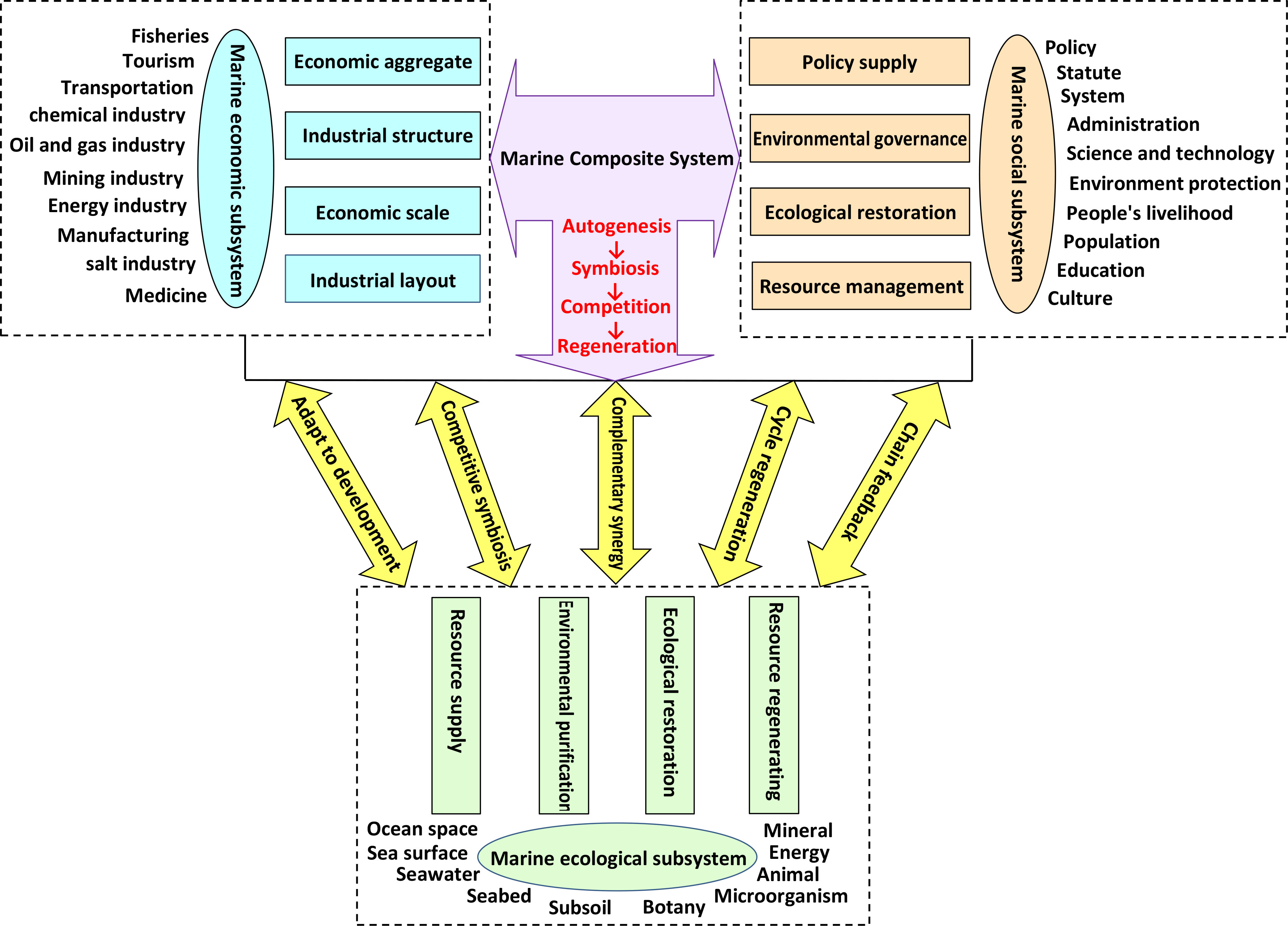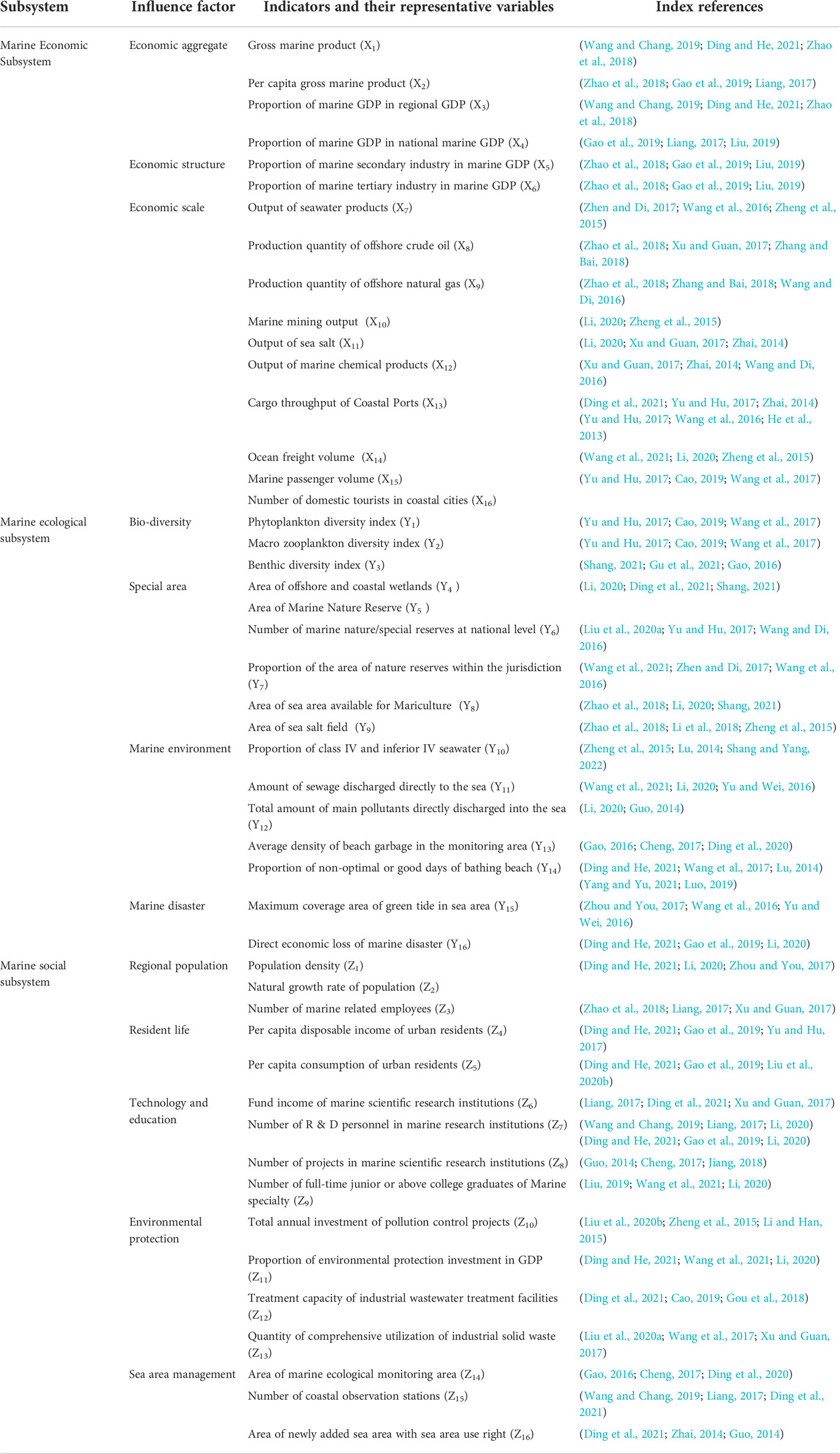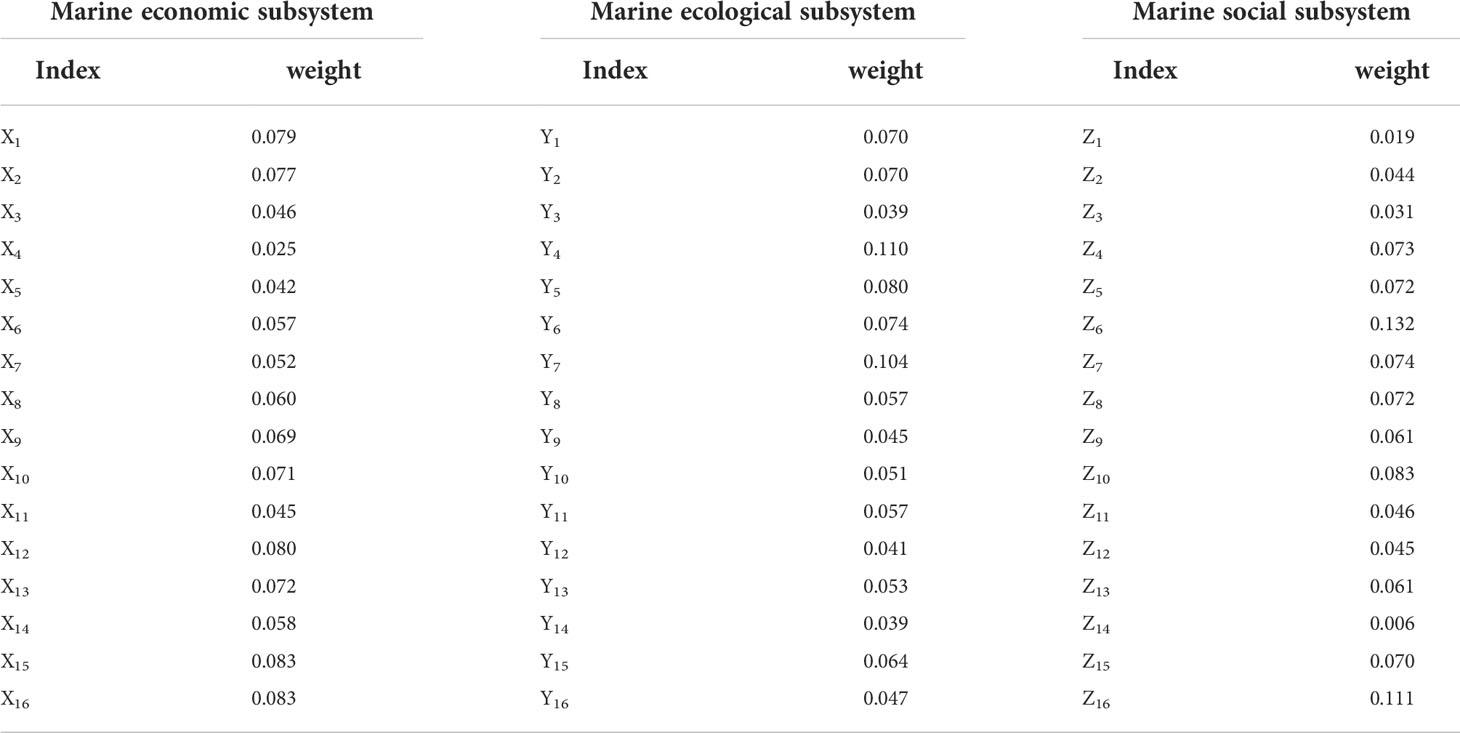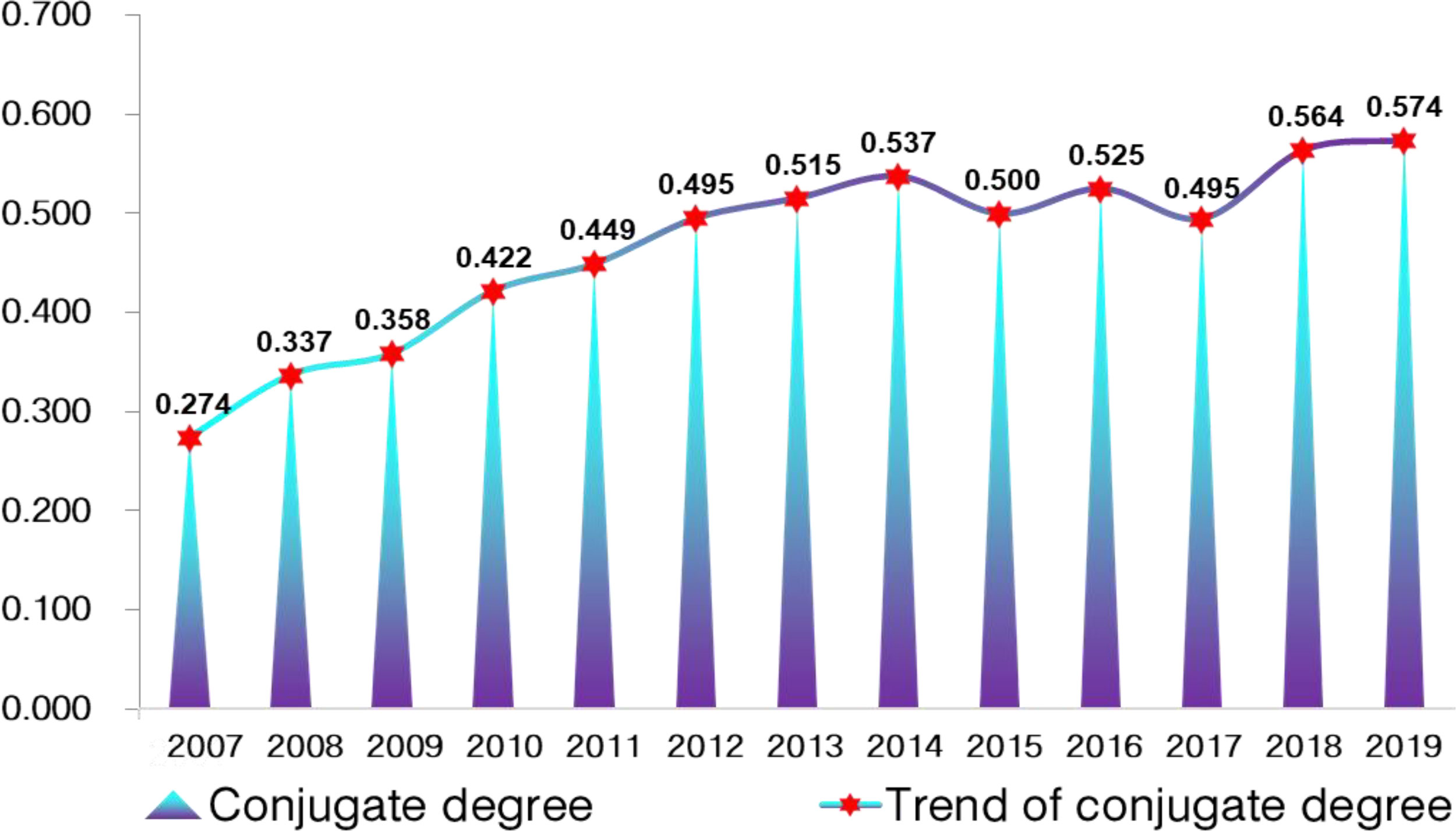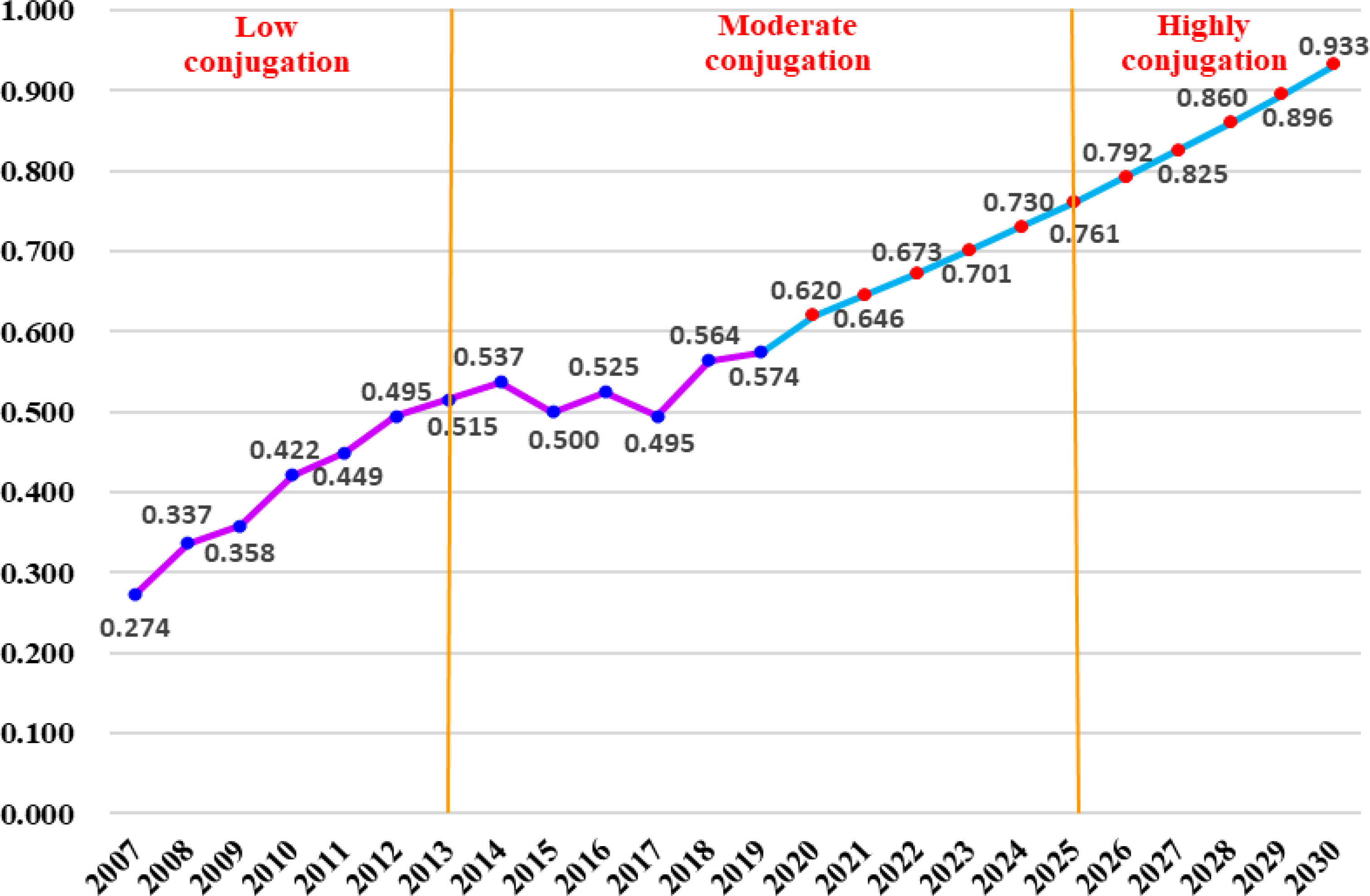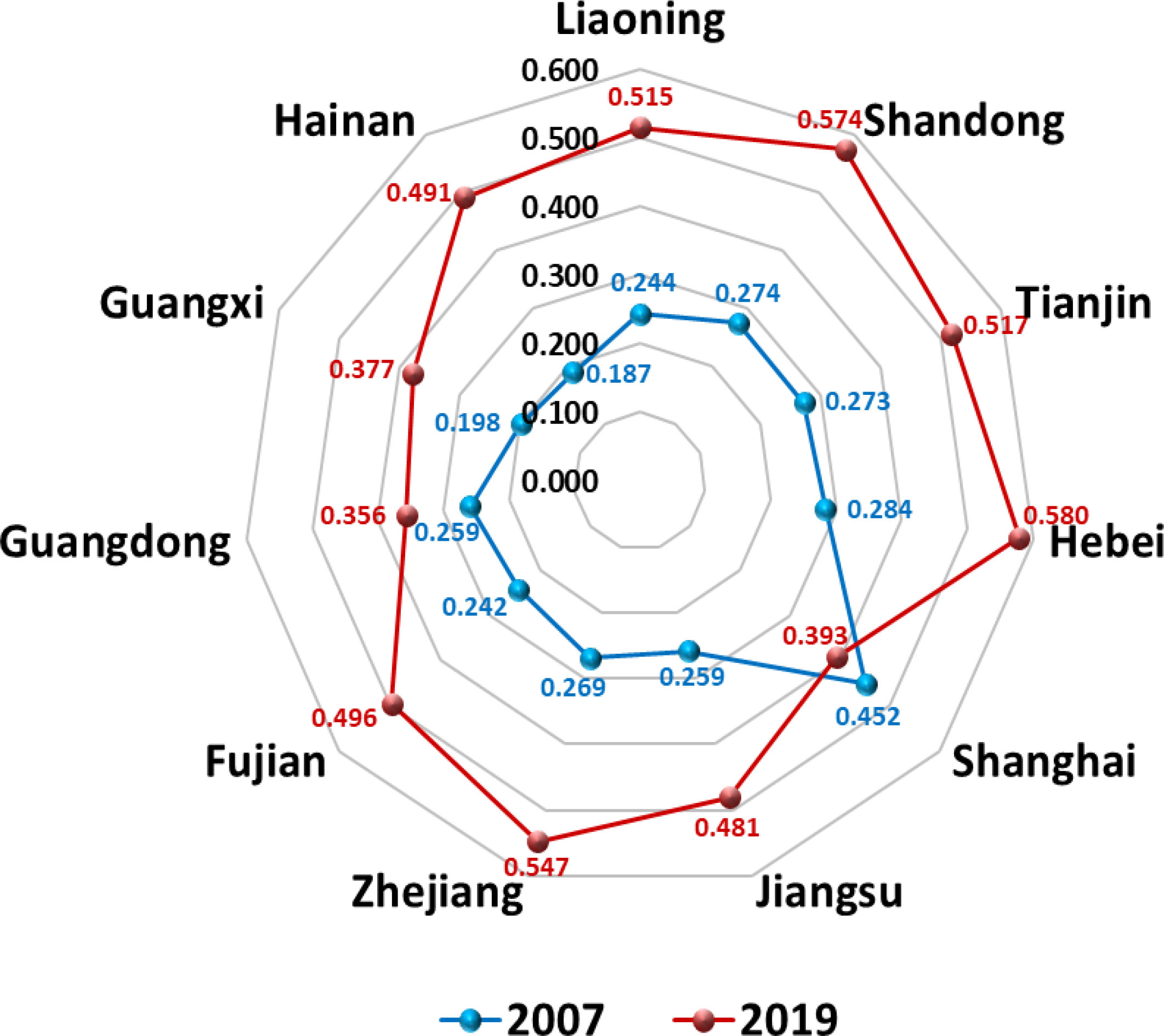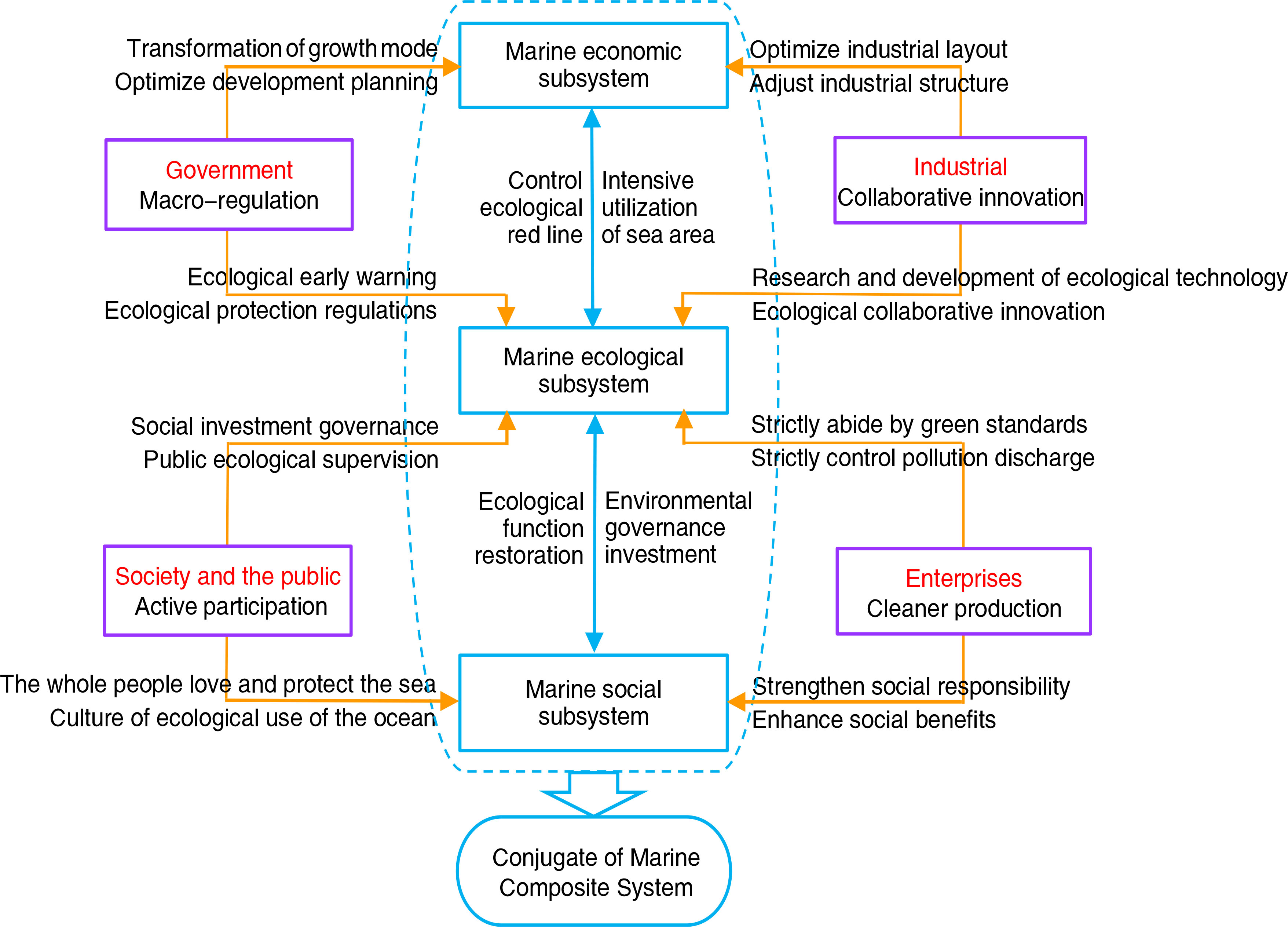- 1Business College, Qingdao University, Qingdao, China
- 2Management College, Ocean University of China, Qingdao, China
As of now, the development and utilization of marine resources have entered a new stage of “refinement, orderliness, and high quality”. It has become a top priority to coordinate the relationship among marine economy, ecology, and society. At the same time, the comprehensive evaluation of the conjugacy of the marine composite system has replaced the single evaluation that only relies on economic indicators to measure the operation effect of the marine system. The operational effect of the marine system needs to be comprehensively measured from three aspects: the profitability of the marine economic subsystem, the sustainability of the marine ecological subsystem and the effectiveness of the marine social subsystem. The combination of composite ecosystem theory and conjugate ecosystem theory was applied to the marine economic-ecological-social composite system, the concept of “conjugate degree of marine composite system” was proposed, the conjugate mechanism of marine composite system subsystem was discussed, the conjugate degree measurement model and prediction model of marine composite system were constructed, the conjugate degree measurement index system of marine composite system was constructed, and the cases of China’s coastal areas were empirically analyzed. The empirical results show that 1) the conjugation degree of the marine composite system in Shandong Province is in a steady growth and “moderate conjugation” state. 2)The conjugation degree of marine composite systems in China’s coastal areas is mostly in the state of “low conjugation”. 3)The balance development of the three subsystems of marine economy, ecology and society is the basic premise of the high conjugate degree of the marine composite system.4) It is unscientific and unreasonable to measure the development of the marine system by the gross marine product. Finally, the policy recommendations for the conjugate development of the marine composite system were proposed. The multi-objective comprehensive evaluation of ocean system operation was explored to provide decision support and policy basis for promoting the balanced, sustainable and high-quality development of ocean system.
Introduction
The extensive development and indiscriminate exploitation of marine resources have resulted in a series of marine ecological and environmental problems, such as marine resource depletion and marine ecological environment pollution. How to obtain marine economic and social benefits while maintaining marine ecological benefits has become an urgent problem to be solved. As of now, the development and utilisation of marine resources have passed the stage of “extensive, disorderly, and low-quality”, and entered a new stage of “refinement, orderliness, and high quality”. It has become a top priority to coordinate the relationship among marine economy, ecology, and society. At the same time, the comprehensive evaluation of the conjugacy operation of the marine composite system has replaced the single evaluation that only depends on economic indicators to measure the operation effect of the marine system.
The composite ecosystem is a system composed of the economy, ecology, and society with symbiosis, coexistence, and interaction under the guidance of human behaviour, including the three subsystems of the economy, nature, and society (Ma and Wang, 1984), human activities are in such an interactive composite system. The marine composite system comprises the marine economic subsystem, ecological subsystem, and marine social subsystem. The marine ecological subsystem is the foundation of the marine composite system, the marine economic subsystem is the core of the marine composite system, and the marine social subsystem is the carrier of the marine composite system. The three subsystems interact, influence, and coexist to create a complete marine composite system (Chen, 2015). The operation effect of the marine composite system needs to be comprehensively measured from three aspects: the profitability of the marine economic subsystem, the sustainability of the marine ecological subsystem, and the effectiveness of the marine social subsystem (Wang, 2017).
In the process of the development and utilisation of marine resources, the symbiosis of the marine composite system has been gradually recognised: human development activities have led to the deterioration of the marine ecological environment. Marine resources must be utilised and managed in a more sustainable way, the ecology, economy, and society, which are interrelated with the ocean, are extremely important. Mankind’s development and utilisation of the ocean have begun to exceed the ocean’s carrying capacity, so more sustainable utilisation and management methods need to be explored (Costanza, 1999). Studying the interaction between the social system and ecosystem is important for sustainable development (Estoque and Murayama, 2014). The negative impact of human economic and social activities on marine ecology can be alleviated through marine spatial planning of the ecosystem (Manea et al., 2019). The development of marine economy brings great pressure to marine ecology, which is a key issue for large marine ecosystems (LMEs) or national marine utilization (Lin, 2020). The coordination among marine economic system, marine ecosystem and marine social system is an important embodiment of the high-quality development of marine economy (Di et al., 2020). Under the background of the rapid development of marine economy, the marine ecological situation is not optimistic, which poses a great threat to the sustainable development of marine economy (Feng et al., 2021). Within the framework of the new European ecological oriented policy, the “blue economy” is carried out together with the restoration and protection of marine ecosystem services (Gomez and Maynou, 2021). The quality of marine resources and environment is closely related to the level of human economic development and social environmental policies (Wang et al., 2021). China’s marine ecosystem is deteriorating, marine economic growth is slowing down, and coastal society is entering a transition period (Gao et al., 2022). Promoting the coordination and linkage of marine resources environment economy system is a necessary way to enhance the marine carrying capacity of coastal areas (Bin et al, 2022).
Conjugate is a control method based on the principle of ecology, which aims to maintain the dynamic balance of the system. “Yoke” is a herringbone harness that is sleeved on the horse’s neck when the carriage is being driven. It requires a balance of the left and right wheels, a tacit understanding between the vehicle and the horse, harmonious rhythm, and symbiosis between the vehicle and the horse. Improper regulation of the conjugate relationship will lead to the imbalance between the horse and carriage. “Conjugation” refers to mutual influence, mutual restriction, coordinated development, and mutual causality according to specific laws so that the whole system structure is relatively stable, its elements are closely linked, the overall function is coordinated, and the system has strong adaptability to the environment (Zeng and Xiang, 2015). It is a control method with dynamic balance as the main purpose. Conjugate ecological regulation is a composite ecosystem-planning method that coordinates the conjugate relationship between man and nature, resources and environment, production and life, and extension and endogeny (Wang and Ouyang, 2012). Conjugate theory first appeared in mathematics, chemistry, physics, and other disciplines, and was later introduced into urban ecosystem regulation. Based on the composite ecosystem theory, it puts forward the concept of “conjugate ecology” (Wang, 2008), the viewpoint of conjugate ecological restoration (Huang et al., 2008), and the concept of conjugate management, which focus on maintaining and ensuring the safety, stability, and health of the target system and maintaining the dynamic balance of the whole target system (Wang et al., 2009). Conjugate ecological theory is mainly used in urban land planning and management (Jin et al., 2010), urban ecosystem regulation (Yin et al., 2014), urban government planning (Zhu and Zhang, 2014), urban and rural planning (Xu and Chen, 2016), regional development (Wang and He, 2018), evaluation of the comprehensive carrying capacity of regional resources and environment (Huang and Song, 2019), land space ecological restoration planning (Zhao et al., 2022), and renovation of industry heritages (Xu, 2022).
In this study, the combination of the compound ecosystem theory and conjugate ecosystem theory is applied to the marine composite system, which aims to promote the high-quality and sustainable development of marine economy, promote the conjugate operation of the marine economic-ecological-social composite system, and create a new highland for the development of the blue economy.
Conjugate mechanism
Under the conjugate action, the marine ecological structure function, marine economic structure function, and marine social structure function of the subsystem of the marine composite system are unified to achieve a relatively stable dynamic balance, ensure the scientific and reasonable development and utilisation of marine resources, and maintain the coordinated operation of the marine composite system. The interaction and regulation of the three subsystems of the marine economy, ecology, and society constitute an open, complex, dynamic, orderly, and huge system of the ocean.
When the impact of the marine socioeconomic subsystem on marine ecology is controlled within the ideal supply threshold, advanced science and technology, a fair market operation mechanism, and a perfect legal system promote the conjugate development among the three subsystems, enabling the marine composite system to develop efficiently. The coupling process of wave development makes the marine composite system continuously optimised, aiming at maintaining the ecological sustainability of the marine ecological subsystem, improving the sustainable development ability of the marine economic subsystem, and establishing the sustainable support of the marine social subsystem so as to achieve the harmonious and sustainable development of the marine composite system.
The conjugate ecological principle of the ocean—that is, development and adaptation, competitive and symbiosis, complementarity and synergy, circular regeneration and chain feedback—focuses on the development, evolution, integration, coordination, and symbiosis of the composite system of marine economy, marine ecology and marine society. The conjugate mechanism of the subsystem of the marine composite system is shown in Figure 1.
Research methods
Coefficient of variation method
The coefficient of variation method was selected as the weight determination method. The coefficient of variation method is an objective method of weighting that directly uses the amount of information contained in each index and calculates the weight of the index. In the evaluation index system, the greater the difference in the value range of the index, the more difficult it is to achieve. The greater the difference in the value of the index, the more it can reflect the gap of the evaluated unit, and the greater its weight.
Coefficient of variation of index:
where Vi is the coefficient of variation of the index i , also known as the coefficient of standard deviation. σi is the standard deviation of index i. is the average of index i.
Standard deviation of index:
Weight of indicators:
Order degree model
The order degree model was selected to measure the conjugate degree of the marine composite system. The order degree model is a composite system model in which multiple order parameters act on the conjugate evolution of the system. It is mainly used to measure the conjugate level of the subsystem of the composite system. The order degree model mainly focuses on the influence of multiple order parameters in different subsystems, and emphasises the differences of subsystems in composite systems. In a certain stage, the dominant role of order parameters will continue to strengthen until it breaks through the critical point, and it will enter the next stage with the emergence of another order parameter. In this stage, the role of order parameters has upper and lower limits, and the measure of conjugation degree depends on the position of order parameters.
The order degree model was used to measure the conjugate level. First, the contribution degree of order parameters in each subsystem is integrated. Second, the conjugate level is displayed through the change of system order degree in different periods (Liu, 2015).
Contribution degree of order parameter
Suppose that the composite system is composed of several subsystems; that is, the composite system S=(S1,S2,⋯,Sn) , Sn is the nth subsystem in the system. In the evolution process of subsystem Sj(j∈[1,n]) , the order parameter ej=(ej1,ej2,⋯,ejm) , where m≥1, βji≤eji≤αji , i=1,2,⋯,m , and αji And βji are the upper and lower limits, respectively, of the order parameter components at the critical point of the system. The change of order parameter has two effects on the conjugation level of the system. One is the positive index; that is, with the increase of order parameter, the order degree of the system will increase; The second is the negative exponent; that is, with the increase of order parameter, the order degree of the system will decrease. Therefore, assuming that the positive indicators include ej1, ej2, ⋯, ejk,and the negative indicators include ejk+1,ejk+2,⋯,ejn , the order degree of the order parameter eji of subsystem Sj is:
Where μj(eji)∈[0,1], and the larger the value of μj(eji) , the higher the contribution of the order parameter eji to the order of the system. The total contribution of order parameter eji to the system can be realised through the integration of μj(eji) , which was carried out by the method of linear weighted summation:
Conjugate degree of system
Assuming that the given initial time of the system is t0 , the order degree of subsystem Sj is , and the order degree of time t1 in the process of system evolution is , then the system conjugate degree in this stage is:
In the above formula, the condition for the existence of the positive conjugate degree of the system is θ , whose value must meet ; otherwise, it indicates that at least one subsystem in the composite system is not developing in an orderly direction. In the [t0,t1] period, the higher the C value, the higher the order degree of the system; that is, the system is in the conjugate evolution state, and the conjugate level is higher.
Classification standard of conjugate degree of system
The classification standard of conjugate degree of composite system is shown in Table 1.
Grey prediction method
The Grey System Prediction GM (1,1) model was selected to predict the conjugate degree of the marine composite system. The grey system prediction model has the advantages of a simple operation process, a good short-term prediction effect, high precision, ease of testing, and the ability to fully tap the essence of the system by using differential equations. At the same time, the irregular original data can be generated, and a generation sequence with strong regularity can be obtained.
Application process of grey prediction model
The application process of GM (1,1) grey prediction model is shown in Figure 2.
Class-compare verification
Before applying the GM (1,1) grey system prediction model, the class-compare verification should be carried out, and then the cumulative sequence should be constructed after passing the class-compare verification; If the class-compare verification fails, a smooth transformation will be required to make the level ratio test pass, and then the cumulative sequence can be constructed. The steps of class-compare verification are as follows:
Set sequence x(0)={x(0)(1),x(0)(2),⋯,x(0)(N)} as the original sequence, λ(t) is the class-compare.
If the vast majority of λ(t) values fall within the allowable coverage interval , the GM (1,1) model can be established, and grey prediction can be carried out. Otherwise, it is necessary to pre-process the data properly.
Construction of grey prediction model
The principle of the GM (1,1) grey system prediction model is to generate a new sequence by accumulating a certain data sequence, and the change trend of this sequence is relatively obvious. Based on the cumulative sequence, a new sequence was established, and then the original sequence was restored through reverse subtraction operation so as to obtain the prediction result.
The construction process of GM (1,1) grey prediction model is as follows:
Set the sequence of original data as:
where N is the amount of data.
Accumulate the original data sequence,
x(0), to weaken the volatility and randomness of the random sequence. The cumulative sequence is as follows:
The equal weight sequence of adjacent average values of the cumulative sequence are as follows:
Where Z(1)(k)={0.5x(1)(k−1)+0.5x(1)(k)}, k=2,3,⋯,N The first-order whitening differential equation GM (1,1) about t for x(1) is as follows:
where a, μ are coefficients to be decomposed, which are called the development coefficient and grey action quantity, respectively; the effective interval of a is (−2,2), and the matrix composed of a and u is the grey parameter. First, calculate the parameters a and u , then calculate x(1)(t) , and then calculate the predicted value of x(0) . B is generated from the equal weight sequence of adjacent average values:
Constant term quantity y:
Estimation by least square method:
Obtain the prediction equation:
By cumulatively reducing the value of the sequence and restoring it to the original sequence, the predicted value can be obtained as follows:
If the data have been pre-processed, they need to be transformed to get the predicted value.
Accuracy test of grey prediction
The accuracy test of grey GM (1,1) model can adopt the residual test and posterior error test.
The residual test mainly analyses the reliability, periodicity, or other interferences of the data.
Remnant verification:
If all |ϵ(k)|<0.1 , it meets the higher requirements; if all |ϵ(k)|<0.2 , it meets the general requirements.
The posterior error test evaluates the main characteristics of the residual distribution to determine whether it is stable. The steps are as follows:
Variance of original data:
Variance of residuals:
Posterior error ratio:
Small error probability:
The posterior error ratio C and small error probability P are used to test the prediction accuracy, and the test grade standard is shown in Table 2.
Index system
Referring to the existing research results, this study discussed the influencing factors of the economic, ecological and social subsystems of the marine composite system. The influencing factors of the marine economic subsystem mainly include the marine economic aggregate, marine economic structure, and the marine economic scale (Lu, 2014; Liang, 2017; Zhen and Di, 2017 ; Zhou and You, 2017; Gao et al., 2019; Liu, 2019; Liu et al., 2020b). The influencing factors of the marine ecological subsystem mainly include marine biological conditions, special marine areas, marine environmental conditions, and marine disasters (Yu and Hu, 2017; Cao, 2019; Li, 2020; Ding et al., 2021; Wang et al., 2021). The influencing factors of the marine social subsystem mainly include the regional population, residents’ life, technology and education, environmental protection, and sea area management (Guo, 2014; Zhai, 2014; Gao, 2016; Zhen and Di, 2017; Zhou and You, 2017). According to the influencing factors of subsystem conjugation of the marine composite system, the measurement index system of the conjugation degree of the marine composite system was constructed, as shown in Table 3.
Empirical research
Data sources
The basic data of the empirical study come from the China Marine Statistical Yearbook, the China Environmental Statistical Yearbook, the China Environmental Quality Report, the China Coastal Waters Environmental Quality Bulletin, the China Marine Economic Statistical Bulletin, the Shandong Provincial Marine Ecological Environment Status Bulletin, the Shandong Statistical Yearbook, the Shandong Provincial Statistical Bulletin of National Economic and Social Development, the website of China Oceanic Administration, the website of the Ministry of Ecological Environment, the official website of Shandong Provincial Oceanic Administration, the official website of Shandong Provincial Department of Oceans and Fisheries, and the official website of Shandong Provincial Department of Ecological Environment. The data were released from 2007 to 2021.The data with changed statistical calibre were adjusted, and a small amount of missing data were supplemented by exponential smoothing method.
Measurement and prediction of conjugation degree of marine composite system in Shandong Province
Study area
Shandong Province of China was selected as the study area. Shandong Province is adjacent to the Bohai Sea in the north and the Yellow Sea in the East. The offshore sea area accounts for 37% of the total area of the Yellow Sea and Bohai Sea. The total length of the coastline is 3345 km, accounting for one sixth of the national coastline. It is an important coastal province in China and an important node of China’s Maritime Silk Road. Shandong Province has superior geographical conditions and rich marine resources, with a total sea area of 72200 km2. With obvious advantages for marine resources and environment, it has great marine development potential (Shandong Provincial People’s Government Website, 2022).
Measurement of conjugation degree of marine composite system
The weight of conjugate degree measurement index
According to the basic data of the measurement indicators (see “data source“ for details), we calculated the order degree of the order parameters of each indicator and then used the coefficient of variation method [Formula (3)] to calculate the weight of the measurement indicators of each subsystem, as shown in Table 4.
The order degree of subsystem
According to formula (5), order degree can be calculated. The order degree and its change trend of marine composite system subsystem in Shandong Province from 2007 to 2019 are shown in Figure 3.
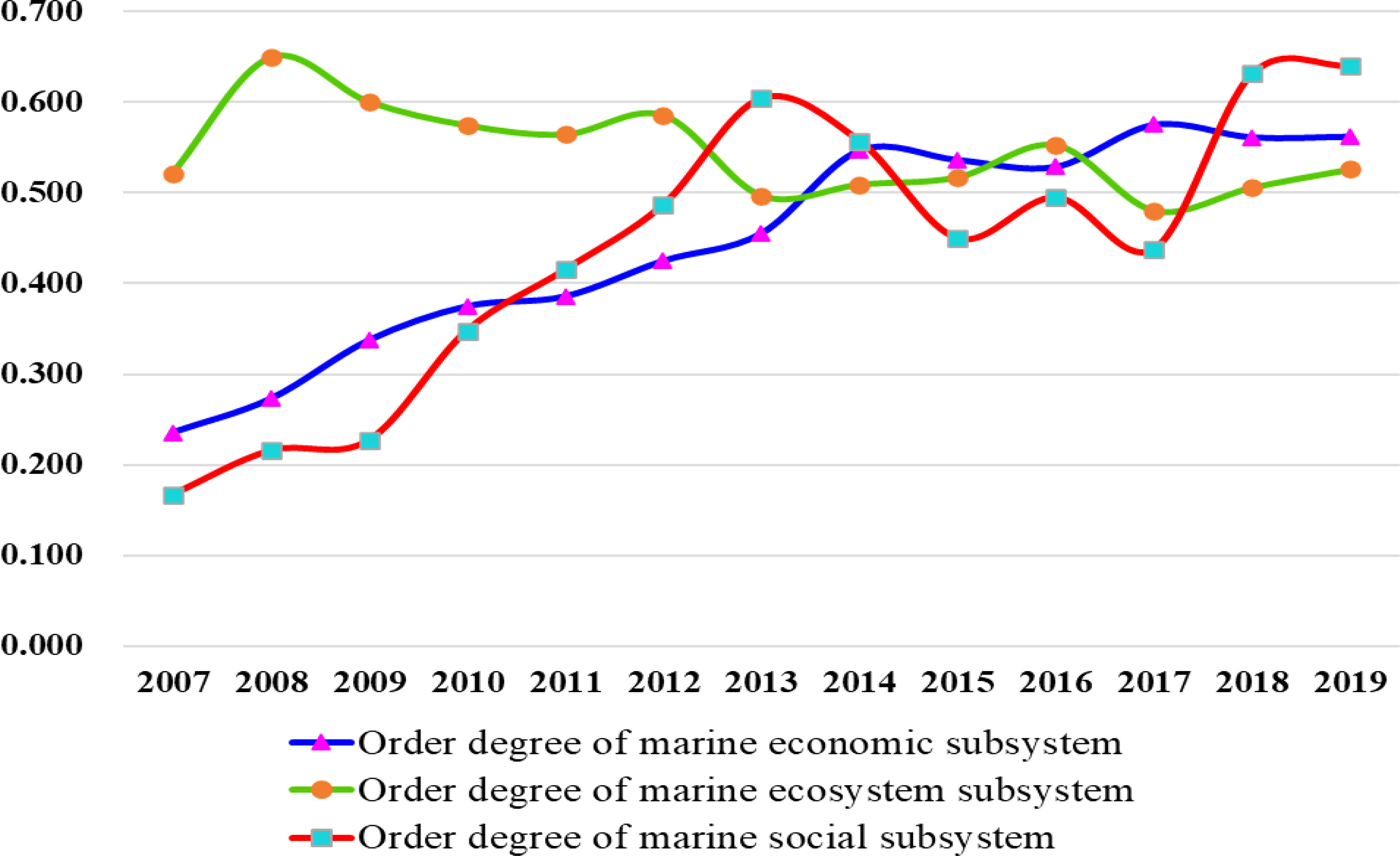
Figure 3 Order degree of subsystems of marine composite system in Shandong Province from 2007 to 2019.
As can be seen from Figure 3, although the order degree of the Shandong marine economic subsystem fluctuated slightly during 2007–2019, it showed a continuous upward trend on the whole. The order degree of the marine ecological subsystem showed a downward trend of volatility. Moreover, the order degree of the marine social subsystem showed a change trend of “rising, falling, fluctuating, and rising”, with two low points in 2015 and 2017.It can be seen that from 2007 to 2019, the development of the three marine subsystems in Shandong Province was unbalanced.
The conjugate degree among subsystems of marine composite system
According to formula (6), subsystems conjugation degree can be calculated. The conjugation degree and its change trend among subsystems of Marine Composite System in Shandong Province from 2007 to 2019 are shown in Figure 4.
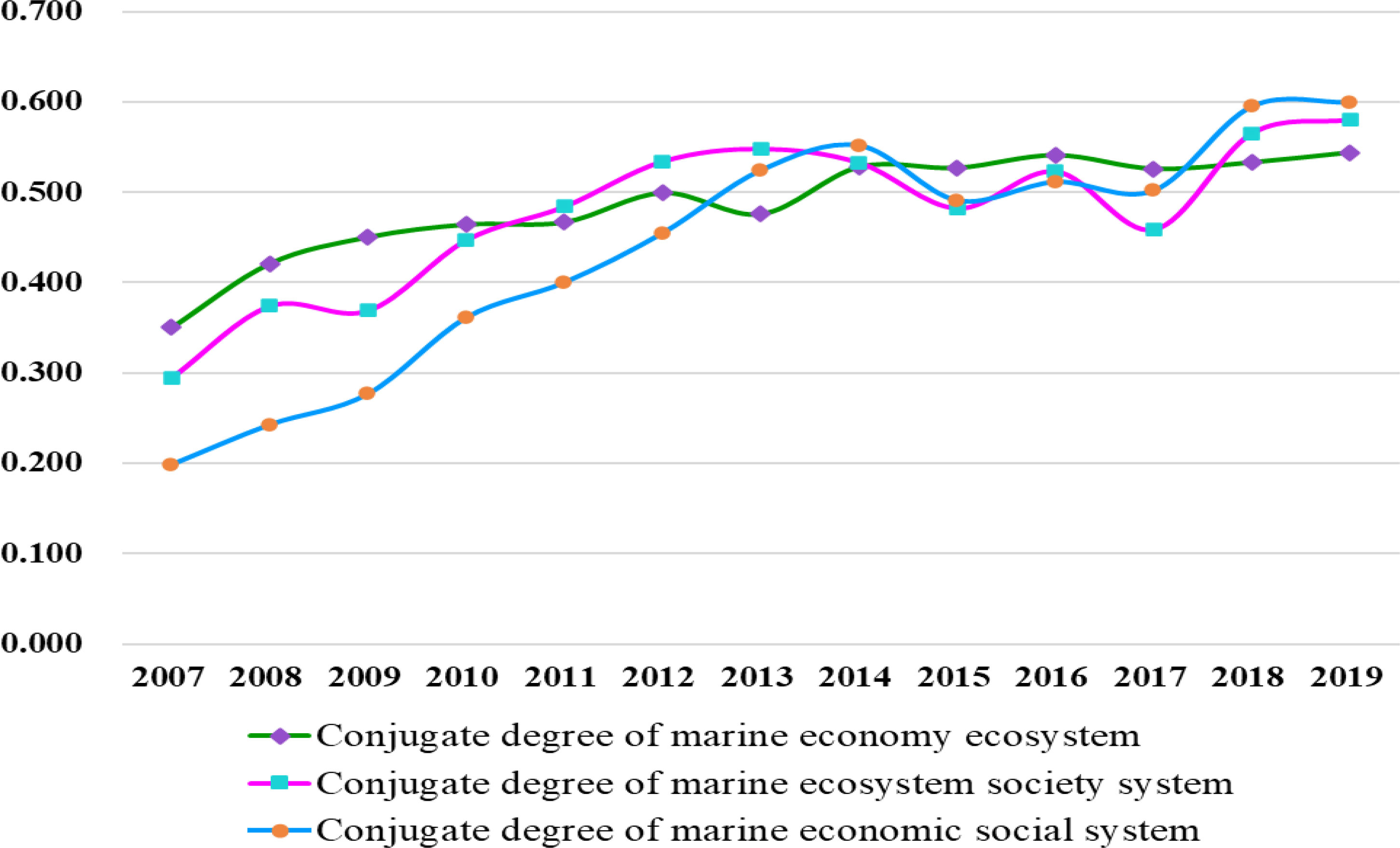
Figure 4 Conjugate degree among subsystems of marine composite system in Shandong Province from 2007 to 2019.
As can be seen from Figure 4, the conjugation degree between the subsystems of the marine composite system in Shandong Province showed a continuous upward trend from 2007 to 2014. There was a downward fluctuation from 2015 to 2017 under the influence of the order degree of the marine social subsystem, and an upward trend from 2018 to 2019. The order degree of the marine social subsystem showed two obvious lows in 2015 and 2017, resulting in two lows in the marine ecological–social system and marine economic–social system in 2015 and 2017. The marine economy ecosystem maintained a steady upward trend, but the order degree of the marine ecological subsystem showed a downward trend, which also slowed down the rising speed of the marine economy ecosystem.
The conjugate degree of marine composite system
According to formula (6), composite system conjugation degree can be calculated. The conjugate degree and its change trend of marine composite system in Shandong Province from 2007 to 2019 are shown in Figure 5.
As can be seen from Figure 5, the conjugate degree of the marine composite system in Shandong Province showed an upward trend from 2007 to 2014, a downward fluctuation from 2015 to 2017, and an upward fluctuation from 2018 to 2019. From 2007 to 2012, the conjugation degree of the Shandong marine composite system was between 0.274 and 0.495, putting in the state of “low conjugation”. From 2013 to 2019, the conjugation degree of the Shandong marine composite system was between 0.515 and 0.574 (except for the conjugation degree of 0.495 in 2017), putting it in the state of “medium conjugation”. The conjugation level of the Shandong marine composite system was improved from 2007 to 2019. From 2015 to 2017, the conjugate degree of the marine composite system in Shandong Province was in a fluctuating adjustment state under the influence of the marine social subsystem.
Prediction of conjugate degree of marine composite system
GM (1,1) grey prediction model was used to predict the conjugate degree trend of Marine Composite System in Shandong Province.
Class-compare verification
According to the calculation results, . The data smoothing method was used to pre-process the data. The processing of the original data aimed to extract the cube root, form a new sequence, and conduct the class-compare verification again. Then, the λ (t) value completely fell within the tolerable coverage range (0.8669, 1.1536), so the class-compare verification passed.
Prediction equation
According to the grey prediction model, the prediction equation was obtained:
The original sequence was restored through the reverse subtraction operation and reverse cubic operation so as to obtain the prediction result.
Accuracy test of grey prediction model
Remnant verification: grey prediction residual error of conjugate degree of Marine Composite System in Shandong Province from 2007 to 2019 is shown in Table 5.
Because all |ϵ(k)|<0.2 , so the remnant verification is passed.
Posterior error test:
S1=0.0794, S2=0.0345, C=S2/S1=0.4342
It can be seen from Table 2 that P ≥ 0.95, and the grade was “excellent”. C = 0.4342, 0.35< 0.4342 ≤ 0.5, the grade was “good”, and the overall prediction grade was “good”. Therefore, the posterior error ratio, C, and the small error probability, p, were used to judge the accuracy of prediction results, the test result was that the prediction accuracy was up to standard and reliable.
The prediction trend of conjugation degree of marine composite system in Shandong province after 2019 can be obtained from the prediction equation (formula 22), as shown in Figure 6.
It can be seen from Figure 6 that the conjugation degree of the marine composite system in Shandong Province was rising as a whole; The conjugation degree of the marine composite system in Shandong Province was in “low conjugation” from 2007 to 2012, entered into “medium conjugation” in 2013, will enter the “high conjugation” stage in 2025, and will enter “extremely conjugate” stage in 2030.
As can be seen from Figure 3, from 2007 to 2019, the order degree of the marine ecosystem subsystem in Shandong Province showed a downward fluctuation, which affected the conjugate degree of the marine composite system to a certain extent. From 2007 to 2013, the order degree of the three subsystems showed a “different direction”, and the development direction of the order degree of the three subsystems has converged in recent years, and the development state is good.
Conjugate degree of the marine composite system and gross marine product in China’s coastal areas
Conjugate degree of the marine composite system in China’s coastal areas
There are 11 coastal areas in China (Liaoning Province, Shandong Province, Tianjin city, Hebei Province, Shanghai City, Jiangsu Province, Zhejiang Province, Fujian Province, Guangdong Province, Guangxi Province and Hainan Province). According to the index data of 11 coastal areas and conjugate degree equation, the conjugate degree of the marine composite system of coastal area was calculated respectively, as shown in Figure 7.
According to the conjugation criteria in Table 1, the conjugation degree is in the range of “0.5 ≤ C > 0.75”, which is “moderate conjugation”. As can be seen from Figure 7, the conjugation status of marine composite systems in 11 coastal areas of China. In 2007, all marine composite systems in coastal areas were in the “low conjugation” status; In 2019, the five coastal areas marine composite systems of Liaoning, Shandong, Tianjin, Hebei and Zhejiang were in the “medium conjugate” state, and the six coastal areas marine composite systems of Shanghai, Jiangsu, Fujian, Guangdong, Guangxi and Hainan were in the “low conjugate” state.
It is worth noting that the conjugate degree of Shanghai’s marine composite system in 2007 is greater than that in 2019, the main reason is that the order degree of the marine ecosystem subsystem in Shanghai decreased from 0.612 in 2007 to 0.332 in 2019, showing a negative growth.
In 2019, the five coastal areas in “moderate conjugation” have the common feature that the development of the three subsystems of marine economy, ecology and society is relatively balanced, and there is no obvious “weakness”.
The common feature of the six coastal areas in “low conjugate” in 2019 is that the development of the three subsystems of marine economy, ecology and society is not balanced. For example, in the three obvious coastal areas (conjugation degree lower than 0.4), Guangdong and Shanghai have relatively developed marine economic subsystems, but weak marine ecological subsystems (heavy marine environmental pollution); The marine ecosystem subsystem of Guangxi is well developed, but the marine economic subsystem is weak (the penultimate marine GDP in 2019).
Gross marine product in China’s coastal areas
Figure 8 shows the gross marine product of China’s 11 coastal areas from 2007 to 2020. Guangdong, Shandong and Fujian provinces rank among the top three in terms of marine GDP; Hebei Province, Guangxi Province and Hainan Province ranked in the last three places.
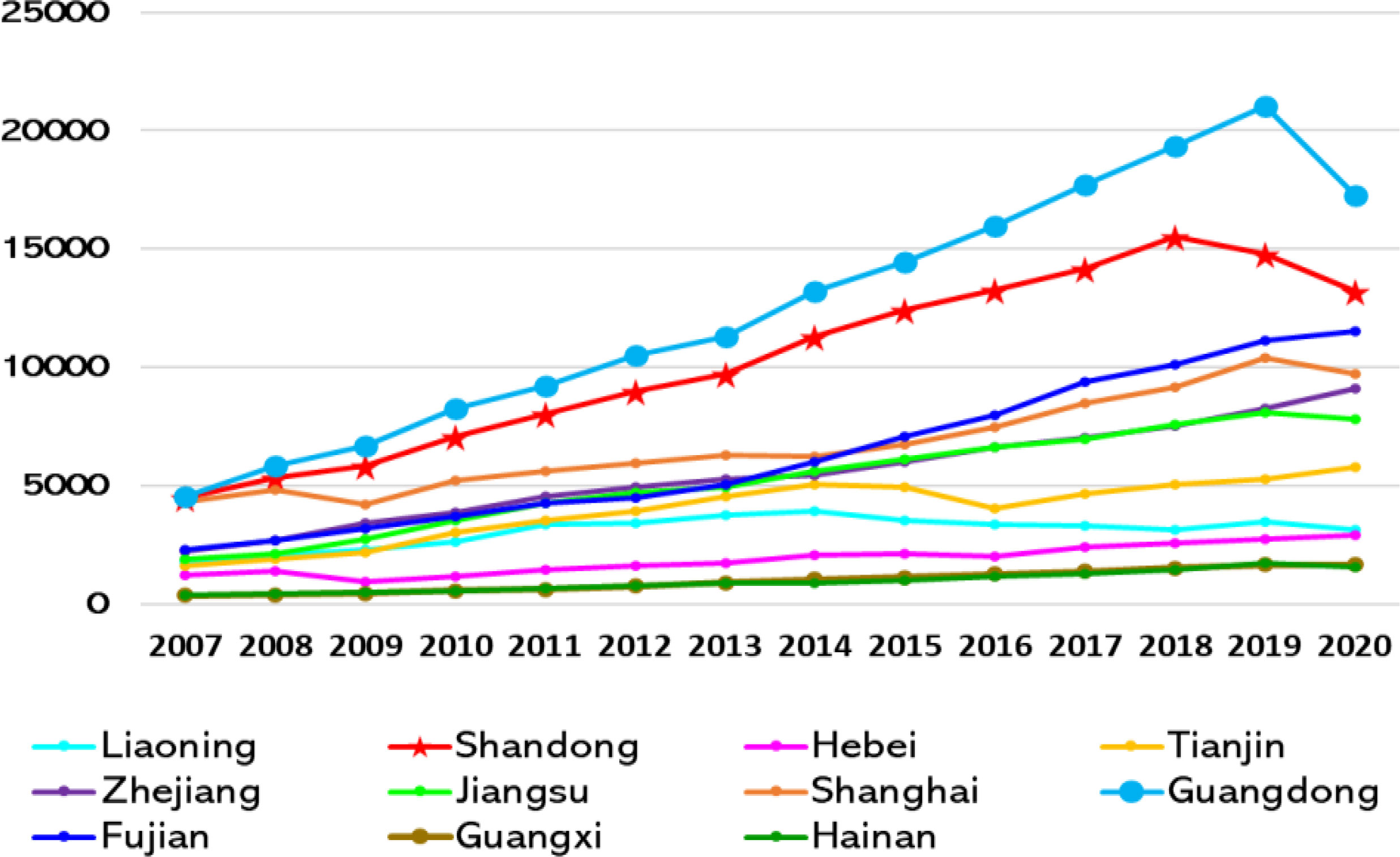
Figure 8 gross marine product of China’s 11 coastal areas from 2007 to 2020 (RMB 100 million) Data sources: China Ocean Statistics Yearbook, China Ocean Economic Statistics Bulletin, 2007-2020.
From 2007 to 2020, the marine GDP of Guangdong Province and Shandong Province were ranked first and second in China, as shown in Figure 8. However, in 2019, the conjugation status of the marine composite system in Guangdong Province was “low conjugation”, and the conjugation status of the marine composite system in Shandong Province was not ideal. The order degree of the marine ecosystem subsystem continued to decline, and the order degree of the marine social subsystem fluctuated greatly. In 2019, it was in a “medium conjugation” state. Therefore, Therefore, it is one-sided to measure the operation of the marine system simply by the gross marine product.
Empirical conclusion
1) The conjugation degree of marine composite system in Shandong Province was in a state of steady growth and “moderate conjugation”.
2)The conjugation degree of marine composite systems in China’s coastal areas was mostly in the state of “low conjugation”.
3)The balance development of the three subsystems of marine economy, ecology and society
is the basic premise of the high conjugate degree of the marine composite system.
4)It is unscientific and unreasonable to measure the development of the marine system by the gross marine product.
Policy recommendations
Policy framework
Build a four in one conjugate regulation mechanism of marine composite system from the four aspects of government, industry, enterprise and society; that is, the mechanism of “Government macro-regulation–Industrial collaborative innovation–Enterprise cleaner production–Social public participation”. The conjugate regulation policy framework of the marine composite system is shown in Figure 9.
Policy decomposition
Government macro-regulation
Strictly control the development and utilization activities that affect the ecological functions of the marine ecological subsystem, and delimit the ecological red line of the sea area, especially the important marine ecological areas, marine ecological functional areas and marine ecological vulnerable areas. According to the temporal and spatial development trend of marine composite system, reasonably regulate the marine ecological protection red line, so as to improve the marine ecological function, ensure the stability of marine ecological subsystem, and balance the relationship between marine ecosystem function and marine economic and social development.
Strengthen the construction of marine ecological protection areas and protect important representative marine ecosystems, such as coastal wetlands, mangroves, islands, and important marine fishery waters. Strictly implement the marine ecological red line system of the whole sea area and bring all marine protected areas, important coastal wetlands, and important sandy coastlines into the control of the ecological red line area so as to effectively protect the marine ecological environment.
Improve the level of sea area supervision by improving marine environment detection and sensing technology, marine environment monitoring platform technology, and data integration and processing technology. Through the development of marine integration and processing technology, ensure the reliability and effectiveness of marine monitoring data and improve the level of marine monitoring and early warning system.
Industrial collaborative innovation
Promote the development of the marine economic subsystem in the direction of marine ecological and environmental friendliness; vigorously develop marine ecological fisheries; shift the traditional marine fishing fishery to the development strategy of ‘focusing on aquaculture and developing both aquaculture and fishing’; and develop service fisheries with low pollution and high return. Examples include coastal fishing and deep processing of marine products and ecological aquaculture. Moreover, reducing the impact of traditional marine fisheries on water pollution and ecological damage is necessary.
Through relevant policies and plans, encourage private capital and social investment to favour green and efficient marine industry; promote the diversified development of the marine industry, especially the vigorous development of marine biological medicine, marine clean energy, coastal tourism, marine high-end equipment manufacturing, and comprehensive utilisation of seawater; and make the marine economic subsystem and marine ecological subsystem work together under the driving force of the marine social subsystem.
Enterprise cleaner production
The pollutants discharged into the sea are the most direct factors affecting the ecological environment of the sea area in the process of sea area utilization. The sewage outlet and discharge volume must be strictly controlled to ensure the healthy development of sea area ecology. There are two aspects to control pollution discharge into the sea. One is to control from the source and use science and technology in enterprise production to reduce pollution; Second, control in the process. Through the monitoring and management of the sewage outlet, control the concentration and total discharge of pollutants and formulate discharge standards.
Enterprise cleaner production involves continuously improving design; using clean energy and raw materials; adopting advanced technology and equipment; and improving management, comprehensive utilisation, and other measures in order to protect the environment. The purpose of enterprise cleaner production is to reduce pollution at the source; improve resource utilisation efficiency; and reduce or avoid the generation and emission of pollutants in the process of enterprise production, service, and product use so as to reduce or eliminate the harm to human health and the environment. Thus, the purpose of protecting marine ecological environment can be achieved through all-round management and control means.
Social public participation
Give full play to the role of marine social organizations in marine development and utilization, improve relevant laws and regulations of marine social organizations, and support and encourage the development of marine social organizations. Strengthen the guidance of citizens’ participation in marine social organisations, introduce corresponding policies and systems, and protect citizens’ rights to freely participate in marine-related social organisations. At the institutional and organisational levels, this approach can ensure that marine social organisations participate in the management of marine affairs. In the context of a policy guarantee, we should emphasise the voluntary equality and cooperation among all social subjects and make them contribute their own resources, jointly manage the environment, and mobilise the whole society to implement large-scale, multi-type, and multi-level development capital investment for marine ecological protection. Raising the public’s awareness of the marine composite system, marine ecosystem services, and the ecological environment carrying capacity of the composite marine system will help promote the connection between science and management (Li, 2014). In order to realise this connection, relevant education policies should be issued for the marine social subsystem, such as increasing the investment policy in marine education, setting up multi-level and multi-field marine education professional policies, and giving appropriate priority to the allocation of marine education resources.
Conclusion
For a long time, there have been several phenomena in the practice of marine resources development and utilization: sacrificing the marine environment for the rapid growth of marine economy; exchange the slow development of marine economy for a good marine environment; the inefficient marine social management capability has affected the development of marine economy and the governance of marine environment. The existence of these phenomena has affected the important role of marine economy in the national economy. The evaluation standard of marine system represents the policy guidance of marine development. The multi-objective balanced development of marine system “economy-ecology-society” is the future development direction, and it is also a proposition with important theoretical and practical value. How to comprehensively and objectively assess the operation of the marine system following the principle of sustainable development? It is particularly important to assess the “conjugation” of marine composite systems.
Limitations
This study focuses on the profitability of the marine economic subsystem, the sustainability of the marine ecological subsystem and the effectiveness of the marine social subsystem. Therefore, the marine economic, ecological and social subsystems are selected to build the marine composite system. In the study of marine composite system, there are other subsystems, such as”marine science and technology-economy-environment composite system” (Wang et al., 2020),”marine ecology-industry composite system” (Gou et al, 2017),”marine ecological civilization-science and technology innovation composite system” (Wang et al, 2021), “marine resources-environment-economy composite system” (Song and Ning, 2021; Bin et al., 2022), “sea-land composite system” (Huang and Fang, 2020), and so on. These marine composite systems are not the focus of this study, so they are not involved in this study.
Data availability statement
Publicly available datasets were analyzed in this study. This data can be found here: The China Marine Statistical Yearbook, the China Environmental Statistical Yearbook, the China Environmental Quality Report, the China Coastal Waters Environmental Quality Bulletin, the China Marine Economic Statistical Bulletin, the Shandong Provincial Marine Ecological Environment Status Bulletin, the Shandong Statistical Yearbook, the Shandong Provincial Statistical Bulletin of National Economic and Social Development, the website of China Oceanic Administration, the data were released from 2007 to 2021.
Author contributions
CZ, data sorting, writing, and manuscript preparation. MW, conceptualization, writing, and manuscript improvement. All authors contributed to the article and approved the submitted version.
Funding
This research was supported by the National Social Science Foundation of China (grant number: 19CJY011) and the Natural Science Foundation of Shandong Province (grant number: ZR2019BG013).
Conflict of interest
The authors declare that the research was conducted in the absence of any commercial or financial relationships that could be construed as a potential conflict of interest.
Publisher’s note
All claims expressed in this article are solely those of the authors and do not necessarily represent those of their affiliated organizations, or those of the publisher, the editors and the reviewers. Any product that may be evaluated in this article, or claim that may be made by its manufacturer, is not guaranteed or endorsed by the publisher.
References
Bin J. Y., Tang X. B., Bai F. C. (2022). Spatiotemporal coupling study on the carrying capacity of marine resources environment economy system in guangdong coastal economic zone. J. Mar. Sci. Bulletin. 41 (1), 82–91. doi: 10.11840/j.issn.1001-6392.2022.01.009
Cao Y. C. (2019). Evaluation of marine resources and environment carrying capacity based on entropy weight TOPSIS Model−a case study of zhanjiang city. J. Mar. Bull. 38 (3), 266–272. doi: 10.11840/j.issn.1001-6392.2019.03.004
Chen W. T. (2015). Study on the coordinated development of fujian marine ecological, economic and social composite system (Fuzhou City in China: D. Fujian Normal University).
Cheng N. (2017). Research on the evaluation system of sustainable development of china's marine economy under the new normal. Study Exploration. 5), 116–122. doi: 10.3969/j.issn.1002-462X.2017.05.018
Costanza R. (1999). The ecological, economic and social importance of the oceans. J. Ecol. Economics. 31 (2), 199–213. doi: 10.1016/S0921-8009(99)00079-8
Ding X. Y., He J. L. (2021). Evaluation of marine resources and environment carrying capacity in Shandong province. J. Mar. Economy 11 (4), 72–79. doi: 10.3969/j.issn.2095-1647.2021.04.009
Ding L. L., Yang Y., Li H. (2021). Two-way evaluation and difference of high-quality development level of regional marine economy. J. Economic Geography. 41 (7), 31–39. doi: 10.15957/j.cnki.jjdl.2021.07.004
Ding L. L., Zhang Y., Xue Y. M. (2020). Research progress on the index system and evaluation method of high-quality development of marine economy. J. Mar. Economy 10 (2), 3–16. doi: 10.3969/j.issn.2095-1647.2020.02.001
Di Q. B., Shang Q., Yu Z. (2020). Research on the coordinated development of marine economic complex system under the goal of high-quality development. J. Mar. Dev. Management. 37 (7), 62–70.
Estoque R. C., Murayama Y. (2014). Social–ecological status index: A preliminary study of its structural composition and application. J. Ecol. Indicators. 43, 183–194. doi: 10.1016/j.ecolind.2014.02.031
Feng L. J., Li F. Q., Yu L. (2021). Study on the correlation between marine ecology and marine economic development based on VAR model. J. Coast. Engineering. 40 (4), 303–312. doi: 10.3969/j.issn.1002-3682.2021.04.007
Gao Q. (2016). Study on comprehensive evaluation of marine economic development quality in 11 coastal provinces and cities of China (Dalian City in China: D. Liaoning Normal University).
Gao L. H., Bao W. L. T. Y., Shi L. (2022). Governance mechanism and performance of marine eco-economic system: Evidence from China. J. Ecol. Indicators. 136 (2), 108668. doi: 10.1016/j.ecolind.2022.108668
Gao Q., Liu T., Wang Y., Ding C. C. (2019). Study on evaluation of coordinated development of marine eco - economic system. J. Mar. Environ. Sci. 38 (4), 568–574.
Gomez Sílvia, Maynou F. (2021). Balancing ecology, economy and culture in fisheries policy: Participatory research in the Western Mediterranean demersal fisheries management plan. J. J. Environ. Management. 291 (8), 112728. doi: 10.1016/j.jenvman.2021.112728
Gou L. F., Wang Y. T., Jin W. B. (2018). Evaluation of qingdao marine resources and environment carrying capacity based on entropy weight TOPSIS model. J. Mar. Environ. Sci. 37 (4), 586–594.
Gou L. F., Yang S. W., Gao Q. (2017). Research on marine ecological security measurement method based on marine ecological industrial composite system. J. Fishery Inf. Strategy. 32 (2), 106–111. doi: 10.13233/j.cnki.fishis.2017.02.004
Guo Y. (2014). Study on the evaluation of the comprehensive development capacity of marine economy in coastal areas. J. Mar. Economy. 4 (4), 1–8.
Gu Y. J., Qian L. F., Bie M. (2021). Jiangsu marine economy high quality development level evaluation and countermeasure research. J. Mar. Dev. Manage. 12), 32–40. doi: 10.3969/j.issn.Doi.1005-9857.2021.12.005
He X. J., Fan H. Q., Hu B. Q. (2013). Evaluation on the sustainable development ability of guangxi marine economy in recent ten years. J. Mar. Dev. Manage. 8), 107–112. doi: 10.3969/j.issn.1005-9857.2013.08.024
Huang W. B., Fang H. (2020). Research on the coordinated development of fujian province sea land composite system. J. J. Fuzhou University. 5), 41–47. doi: 10.3969/j.issn.1002-3321.2020.05.008
Huang J. L., Ou J. M., Wang R. S., Yang W.R.. (2008). Discussion on ecological restoration model in mentougou district of Beijing. J. J. Ecology. 27 (02), 273–277.
Huang X. J., Song Y. Y. (2019). Evaluation model of comprehensive carrying capacity of regional resources and environment based on conjugate angular force mechanism. J. J. Natural Resources. 34 (10), 2103–2112. doi: 10.31497/zrzyxb.20191007
Jiang L. (2018). Research on evaluation of comprehensive development strength of regional marine economy in China. J. Special zone economy. 3), 38–42.
Jin J. S., Wang R. S., Huang J. L. (2010). Conjugate regulation method of urban ecology, population. A. Proc. China Sustain. Dev. Forum., 391–395.
Li H. Q. (2014). On the theory of collaborative governance. J. Theory Monthly. 1), 138–142. doi: 10.3969/j.issn.1004-0544.2014.01.032
Li H. (2020). Evaluation and prediction of marine comprehensive carrying capacity in zhejiang province (Zhoushan City in China: D. Zhejiang Ocean University).
Liang Y. H. (2017). Research on the index evaluation system of strong marine province (Dalian City in China: D. Dalian Maritime University).
Li B., Han Z. L. (2015). Evaluation on the coordination degree of marine economy and socio-economic development in liaoning province. J. Mar. Dev. Management. 4), 93–97. doi: 10.3969/j.issn.1005-9857.2015.04.023
Li G. Z., Hao T. T., Zhao K. X. (2018). Analysis on the coupling and coordinated development of marine economy, resources and environment in china's coastal areas. J. J. Jilin Normal Univ. 2), 81–87. doi: 10.3969/j.issn.2096-2991.2018.02.011
Lin Y. Q. (2020). Coupling analysis of marine ecology and economy: Case study of shanghai, china. J. Ocean Coast. Management. 195 (9), 105278. doi: 10.1016/j.ocecoaman.2020.105278
Liu Y. J. (2015). Research on the coordinated development of technological innovation, institutional innovation and industrial high-end in high-tech industry–an empirical analysis based on the synergy degree model of composite system. J. Sci. Technological Prog. Countermeasures. 32 (2), 66–72. doi: 10.6049/kjjbydc.2014080063
Liu X. (2019). Research on the evaluation of marine economic development level in Shandong province (Changsha City in China: D. Central South University of Forestry and Technology).
Liu B., Long R.Y., Zhu C.G., Sun X.X., Pan K.Y. (2020a). Evaluation on high quality development level of marine economy in jiangsu province. J. Economic Geography. 40 (8), 104–113. doi: 10.15957/j.cnki.jjdl.2020.08.013
Liu B., Long R.Y., Zhu C.G., Sun X.X. (2020b). Measuring the level of coordinated development of marine economy and ecological environment. J. Explor. Economic Problems. 12), 55–65.
Lu W. (2014). Evaluation of sustainable development of marine ecological economy in jiangsu province (Qingdao City in China: D. Ocean University of China).
Luo M. (2019). Distribution of enteromorpha green tide in jiangsu province sea area and its impact on ecosystem. J. Environ. Dev. 31 (11), 177–179. doi: 10.16647/j.cnki.cn15-1369/X.2019.11.100
Manea E., Di Carlo D., Depellegrin D., Agardy T., Gissi E. (2019). Multidimensional assessment of supporting ecosystem services for marine spatial planning of the Adriatic Sea. J. Ecol. Indicators. 101, 821–837. doi: 10.1016/j.ecolind.2018.12.017
Shang Q. (2021). “Research on evaluation and early warning of coordinated development of liaoning marine economic system,” (Dalian City in China: D. Liaoning Normal University).
Shang S. Z., Yang Z. Q. (2022). Study on the evaluation of coordinated development of marine economic ecosystem in jiangsu province. J. View Land Bridge. 1), 31–33. doi: 10.3969/j.issn.1005-9857.2021.12.005
Song Z. M., Ning L. (2021). Research on the evolution of china's marine resources environment economy complex system − an empirical analysis based on logistic model. J. Mar. Science. 45 (8), 21–33. doi: 10.11759/hykx20200625001
Wang R. S. (2008). Symphony of green rhyme and red vein: Discussion on urban conjugate ecological planning method. J. J. Urban Planning. 1), 8–17. doi: 10.3969/j.issn.1000-3363.2008.01.002
Wang S. (2017). Study on efficiency of marine composite system in coastal provinces and cities of China (Dalian City in China: D. Liaoning Normal University).
Wang B., Chang J. C. (2019). Evaluation and analysis of marine economic competitiveness in china's coastal areas. J. Mar. Dev. Management. (7), 77–88. doi: 10.3969/j.issn.1005-9857.2019.07.014
Wang S. H., Chen S. S., Zhang H. Y., Song M. L. (2021). The model of early warning for china's marine ecology-economy symbiosis security. J. Mar. Policy. 128 (6), 104476. doi: 10.1016/j.marpol.2021.104476
Wang M., Di Q. B. (2016). Study on the coupling relationship between the carrying capacity of marine resources and the development potential of marine economy in the bohai rim region. J. Mar. Dev. Management. 1), 33–39. doi: 10.3969/j.issn.1005-9857.2016.01.005
Wang Y. M., Di M. Q., Wang Y. C. (2021). Study on the coupling and coordinated development of marine economic composite system in Shandong province. J. J. Shandong Institute Business Technology. 35 (5), 1–10. doi: 10.3969/j.issn.1672-5956.2021.05.001
Wang J., Yang K., Wang H., Chen X. (2016). A study on the spatiotemporal coupling between the utilization of marine resources and economic development in china's coastal areas. J. J. Guangdong Ocean University. 36 (5), 15–22. doi: 10.3969/j.issn.1673-9159.2016.05.003
Wang J., He H. X., Chen K., Liu Y., Zhang Y., Ke H. W., et al. (2017). Comprehensive evaluation of sustainable development ability of marine ecology in Shandong peninsula blue economic zone based on DPSIR model. J. Mar. Sci. 41 (7), 129–136. doi: 10.11759/hykx20170110003
Wang Y. S., Li Y. H., Jie X. M., Li Y. L., Li G. J., Wang W. T. (2020). Time and space evolution of the coupling and coordination of china's marine science technology-economy-environment system. J. China's Population Resour. Environment. 30 (8), 168–176. doi: 10.12062/cpre.20200312
Wang Y. H., He H. Y. (2018). How to realize the symbiotic conjugate of “people, industry and city”. J. Frontline. 11), 76–78. doi: 10.3969/j.issn.0529-1445.2018.11.023
Wang Z. F., Li T., Gao W. M. (2021). Coupling analysis of marine resources and environment carrying capacity and economic development level in coastal areas of hebei province. J. Mar. Limnology Bulletin. 43 (6), 58–65. doi: 10.13984/j.cnki.cn37-1141.2021.06.009
Wang R. S., Ouyang Z. Y. (2012). Social economic natural complex ecosystem and sustainable development. J. J. Chin. Acad. Sci. doi: 10.3969/j.issn.1000-3045.2012.03.012
Wang J. W., Zhou Y., Li B. Y., Liu D. J. (2009). Preliminary study on conjugate management of eco geological environment system in dahe source area. J. Regional Res. Dev. 28 (06), 86–90. doi: 10.3969/j.issn.1003-2363.2009.06.018
Xu L. J. (2022). Research on the renewal and transformation mode of industrial relics based on “conjugate theory”. J. J. western Hum. settlements. 37 (1), 70–77. doi: 10.13791/j.cnki.hsfwest.20220111
Xu Q., Chen Yi. (2016). ). exploration of urban and rural master planning under the paradigm of conjugate ecological planning. J. Jiangsu Urban Planning. 1), 13–18.
Xu S. T., Guan W. (2017). Evaluation on sustainable development of marine economy in bohai rim region. J. China's Mar. Economy. 2), 119–134.
Yang X. Y., Yu J. (2021). Evaluation of marine ecological environment based on Bayesian Network−a case study of Shandong province. J. Mar. bulletin. 40 (4), 473–480. doi: 10.11840/j.issn.1001-6392.2021.04.014
Yin K., Wang R. S., Yao L., Liang J.. (2014). Conjugate ecological management of urban land based on complex ecological functions. J. J. Ecology. 34 (1), 210–215. doi: 10.5846/stxb201304280868
Yu X., Hu Q. G. (2017). Evaluation of marine ecological carrying capacity in zhejiang province based on ecosystem health. J. Technol. Economy. 30 (2), 46–50.
Yu J. K., Wei Y. (2016). Research on vulnerability assessment of marine economic system based on set pair analysis. J. Mar. Economy. 6 (2), 26–33. doi: 10.3969/j.issn.2095-1647.2016.02.004
Zeng P., Xiang L. (2015). Research on the conjugate drive of higher education investment and industrial agglomeration level to regional economic growth in china’s top ten urban agglomerations. J. J. Yunnan Normal University Philosophy Soc. Sci. Edition. 47 (4), 138–145.
Zhai R. X. (2014). Measurement and evaluation of marine carrying capacity in jiangsu province. J. Jiangsu Agric. Science. 42 (4), 398–401. doi: 10.15889/j.issn.1002-1302.2014.04.137
Zhang X., Bai F. C. (2018). Study on the coupling relationship between marine resources and environment system and marine economic system in guangdong province. J. Ecol. Economy 34 (9), 75–80.
Zhao D., Huang X. C., Fu L. P., Li Z. Y. (2022). The study on the planning strategy of ecological restoration of Beijing land space based on conjugate ecological theory. J. Urban Dev. Res. 29 (5), 21–27.
Zhao L. D., Shao S. Y., Sui H. K. (2018). Study on the coupling coordination between marine industry agglomeration and marine ecological resources and environment in Shandong province. J. Oriental Forum. 3), 29–34. doi: 10.3969/j.issn.1005-7110.2018.03.005
Zhen J. H., Di Q. B. (2017). The coupling analysis between the development level of marine economy and the carrying capacity of the bohai rim region. J. Mar. economy. 7 (5), 37–46. doi: 10.3969/j.issn.2095-1647.2017.05.005
Zheng L., Cai D. H., Yang Na. (2015). An empirical study on marine economic evaluation system based on sustainable development. J. Mar. Economy. 5 (1), 21–31.
Zhou L., You G. B. (2017). Evaluation and model selection of sustainable development of marine ecological economy in fujian province. J. Mar. Economy. 7 (2), 30–37. doi: 10.3969/j.issn.2095-1647.2017.02.005
Keywords: marine composite system, conjugation mechanism, conjugate degree, policy framework, China coastal area
Citation: Zhang C and Wang M (2022) Assessing the conjugacy of the marine economy-ecology-society composite system: China’s Case. Front. Mar. Sci. 9:963468. doi: 10.3389/fmars.2022.963468
Received: 07 June 2022; Accepted: 07 July 2022;
Published: 08 August 2022.
Edited by:
Kum Fai Yuen, Nanyang Technological University, SingaporeReviewed by:
Xue Li, Nanyang Technological University, SingaporeQingji Zhou, Tianjin University, China
Copyright © 2022 Zhang and Wang. This is an open-access article distributed under the terms of the Creative Commons Attribution License (CC BY). The use, distribution or reproduction in other forums is permitted, provided the original author(s) and the copyright owner(s) are credited and that the original publication in this journal is cited, in accordance with accepted academic practice. No use, distribution or reproduction is permitted which does not comply with these terms.
*Correspondence: Cai Zhang, NDM0MjE0NDg2QHFxLmNvbQ==; Miao Wang, d2FuZ21pYW94eEAxMjYuY29t
 Cai Zhang1*
Cai Zhang1* Miao Wang
Miao Wang